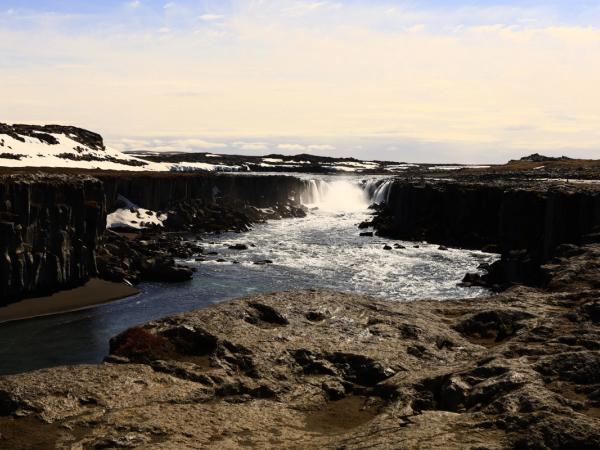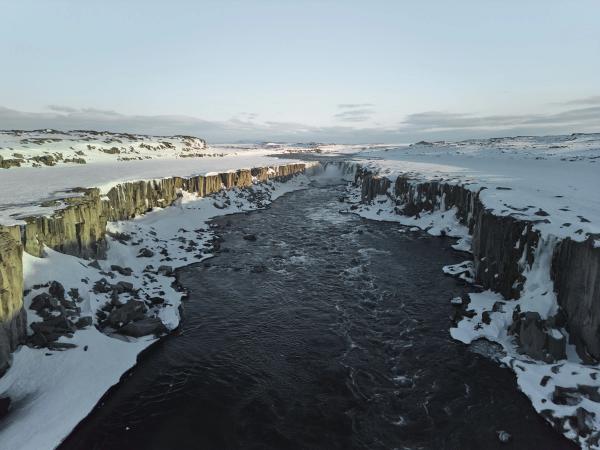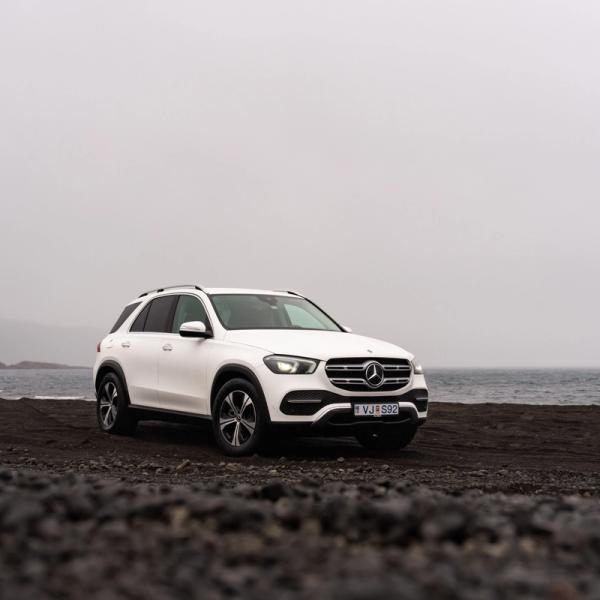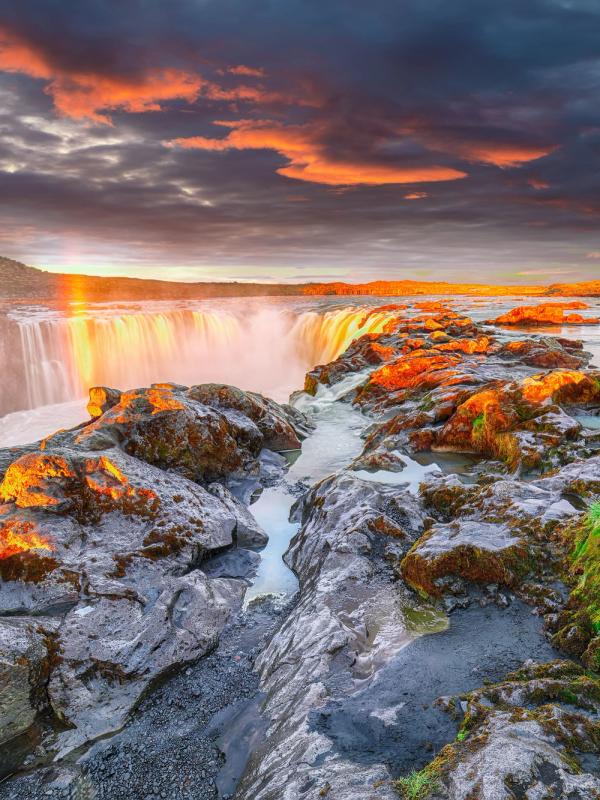
Selfoss Waterfall: The Peaceful Waterfall of North Iceland
If you're going to Iceland, make sure to visit Selfoss waterfall. Located in the scenic Jökulsárgljúfur canyon, Selfoss has a wide, beautiful cascade and a peaceful atmosphere. It's perfect for nature lovers and photographers, offering a quieter experience compared to the powerful Dettifoss nearby.
Key Takeaways
- The area around Selfoss has unique rock formations and lush landscapes, perfect for exploring
- You can see both Selfoss and the powerful Dettifoss waterfall in one trip.
- Selfoss is very far from Reykjavik. It's better to visit from Akureyri
- The region is great for hiking and offers chances to see the Northern Lights.
Why is Selfoss Waterfall Worth a Visit?
Selfoss waterfall is worth visiting for its wide and beautiful cascade in Jökulsárgljúfur canyon. Unlike the powerful Dettifoss nearby, it's a peaceful spot. The area has unique rock formations and lush scenery, perfect for nature lovers and photographers.
Selfoss stands out because it’s in a remote part of Iceland. Getting there takes you through stunning countryside. Its calmness offers a nice contrast to the intense Dettifoss, showing a quieter side of Iceland's waterfalls.
For photographers, Selfoss offers many great views. In summer, the wide falls look fantastic against the rocky canyon and greenery. In winter, it becomes a snowy wonderland, providing a different kind of beauty.
Hiking around Selfoss is a fun experience. The trails are easy to explore and suitable for most people. You'll enjoy the beautiful views and the adventure of walking through the rugged terrain.
Selfoss Waterfall Facts & Features
Selfoss Waterfall is a remarkable natural feature with several unique aspects:
- Height: The waterfall drops 11 meters (36 feet), which might seem modest, but its width and volume make it impressive.
- Width: Spanning about 100 meters (330 feet), the waterfall creates a broad, majestic flow.
- River: The falls are part of the Jökulsá á Fjöllum river, which is fed by the Vatnajökull glacier, the largest glacier in Europe. This river's glacial origins give the water a unique, milky color, especially noticeable in the summer months when the glacier melts more rapidly.
- Name Meaning: "Selfoss" comes from the Icelandic word for "seal," although there's no direct connection to seals at this location. Note that there's also a town called Selfoss in Southern Iceland, which can be confusing. The waterfall and the town are distinct places, with the waterfall being in the northern part of the country.
Where’s Selfoss Waterfall and How to Get There?
Selfoss waterfall is in North Iceland, in the Jökulsárgljúfur canyon. It’s about 90 kilometers (56 miles) from Akureyri. From Reykjavik, it’s around 530 kilometers (329 miles), which is roughly a 6.5-hour drive. You’ll mainly drive along the Ring Road (Route 1) and then take Route 862 or 864 to reach the falls. Route 862 is paved and more accessible, while Route 864 is a bit rougher but less crowded.
Seeing Selfoss Waterfall from the West Side
To view Selfoss from the west side, take Route 862, also known as Vesturdalur. This road is paved and more accessible, making it a better option for most vehicles and year-round travel. The west side offers a panoramic view of both Selfoss and Dettifoss, giving you a chance to see both waterfalls in one trip. The hike from the parking area to the falls is about 1.5 kilometers (1 mile) and is relatively easy, providing a more leisurely experience compared to the east side.
Seeing Selfoss Waterfall from the East Side
To see Selfoss Waterfall from the east side, follow Route 864, also known as Hólsfjallavegur. This route is unpaved and more rugged, offering an adventurous drive. It is usually open from late spring to early autumn; it's closed during the winter months due to snow and ice. The east side provides a closer and more direct view of the waterfall, making it an excellent spot for photographers. Be prepared for a bumpy ride, and ensure your vehicle is suitable for gravel roads.
Getting there from Akureyri (Fastest Route, With Tolls)
1. Start in Akureyri:
- Take Skipagata to Drottningarbraut (1 min, 250 m)
- Head southeast on Skipagata toward Hofsbót (210 m)
- Turn left onto Kaupvangsstræti (35 m)
2. Follow Þjóðvegur to Þingeyjarsveit:
- Turn right onto Drottningarbraut (1.3 km)
- Turn left onto Þjóðvegur (4.0 km)
- At the roundabout, take the 1st exit and stay on Þjóðvegur (73.5 km)
- Turn right onto Kísilvegur/Þjóðvegur (3.9 km)
- Turn left onto Þjóðvegur (25.8 km)
3. Take Dettifossvegur to Dettifossvegur vestri:
- Turn left (5.0 km)
- Continue onto Dettifossvegur (16.1 km)
- Turn right onto Dettifossvegur vestri (2.7 km)
This route will take approximately 1 hour and 43 minutes, covering about 132.8 kilometers.
Getting there from Reykjavik (Not Recommended)
1. Start in Reykjavik:
- Take Garðastræti and Suðurgata to Hringbraut/Route 49 (5 min, 1.2 km)
2. Follow Þjóðvegur to Þingeyjarsveit:
- Continue on Hringbraut/Route 49
- Follow Þjóðvegur (Route 1) for 495 km (approximately 6 hr 3 min)
3. Take Dettifossvegur to Dettifossvegur vestri:
- Turn onto Dettifossvegur (Route 862) and continue (18 min, 23.8 km)
This route will take approximately 6 hours and 26 minutes, covering about 520 kilometers.
What to Wear When Visiting Selfoss Waterfall?
When you visit Selfoss Waterfall, it's essential to be prepared for Iceland’s changing weather. Here’s what you should wear:
- Waterproof and Windproof Clothing: The weather can change quickly, so dress in layers that protect against rain and wind.
- Sturdy Hiking Boots: The paths can be rocky and uneven.
- Layers: Dress in layers to adjust to temperature changes.
- Winter Gear: If you’re visiting in winter, wear thermal layers and bring crampons or spikes for icy paths.
- Rain Protection for Electronics: Keep your camera and other devices dry with waterproof covers.
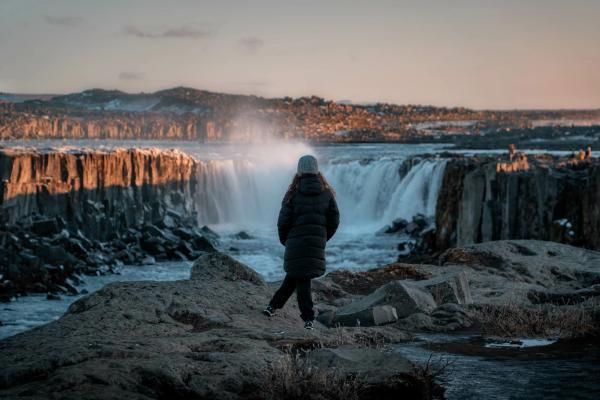
Surrounding Sites & Things to Do Near Selfoss Waterfall
There’s plenty to see and do around Selfoss Waterfall. Explore nearby natural wonders, including other impressive waterfalls, unique rock formations, and lush green canyons.
Dettifoss Waterfall
Just downstream from Selfoss, Dettifoss is Europe's most powerful waterfall, making it a must-see. The sheer power of the water crashing down is an awe-inspiring sight. There are viewing platforms on both sides of the falls, offering different perspectives of this natural wonder.
Hafragilsfoss
Hafragilsfoss is another stunning waterfall nearby. It offers beautiful views and is part of the same Jökulsá á Fjöllum river. It's less crowded than Dettifoss, providing a more serene experience. The waterfall plunges into a deep canyon, creating dramatic and picturesque scenery perfect for photography.
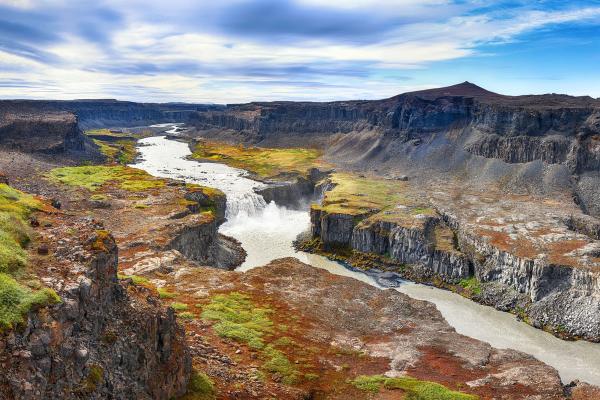
Hljóðaklettar and Ásbyrgi Canyon
Hljóðaklettar, known as "echo rocks," features unique basalt columns that create interesting sounds and formations. This area is great for exploring and listening to the echoes. Ásbyrgi Canyon is a lush, horseshoe-shaped canyon perfect for hiking. The canyon's green, forested floor contrasts beautifully with its towering rock walls.
Lake Mývatn
Lake Mývatn is famous for its diverse birdlife and geothermal activity. Visitors can enjoy hot springs, explore lava formations, and take part in bird watching. The area around the lake offers various hiking trails, making it a great spot for outdoor activities and relaxation in nature.
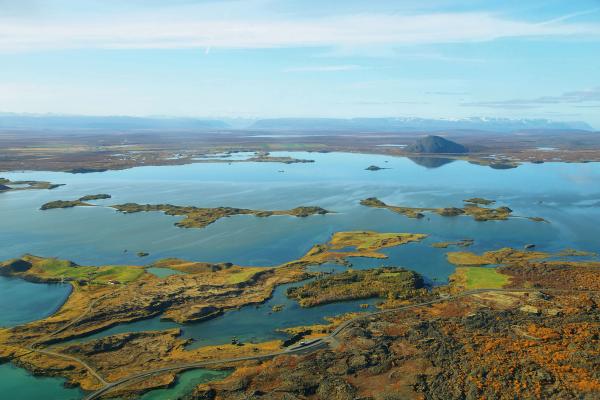
Don't Underestimate Selfoss
Visiting Selfoss waterfall gives you a calm and beautiful experience in Iceland. You can see the gentle Selfoss falls, the strong Dettifoss, and the green Ásbyrgi Canyon in just one go.
There’s a lot to do, whether you want great views, a chance to see the Northern Lights or a nice hike. Selfoss waterfall and its surroundings offer a memorable adventure showcasing Iceland's natural beauty.



